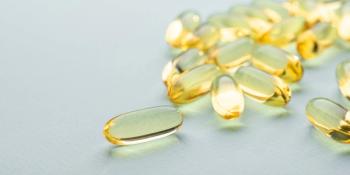
Seeing Stars
Only three more years until the federal government's National Eye Institute (NIH; Bethesda, MD) releases the results of its landmark Age-Related Eye Disease Study (AREDS2). The study-a multicenter, randomized, five-year trial involving 4000 participants-is expected to finish in December 2012.
Only three more years until the federal government's National Eye Institute (NIH; Bethesda, MD) releases the results of its landmark Age-Related Eye Disease Study (AREDS2). The study-a multicenter, randomized, five-year trial involving 4000 participants-is expected to finish in December 2012.
To date, AREDS2 is the largest clinical trial to test age-related macular degeneration (AMD) and the effects of lutein, zeaxanthin, and omega-3 fatty acids. These ingredients weren't included in the original AREDS study-in part because some weren't commercially available or on the eye health radar when the first AREDS study was completed in 2001. (That study included only antioxidant vitamins and minerals: zinc, copper, and vitamins A, C, and E.)
However, the newly added ingredients are ones that have been gaining traction in eye health over the years. Lutein is well established and has already been shown by previous studies to serve as an antioxidant and a blue-light filter, preventing diseases such as AMD and cataracts; improving night vision, visual acuity, and glare recovery; and alleviating eye fatigue. Omega-3, newer to the eye health scene, has been shown to aid against the development of wet and dry AMD. (In fact, in October, AREDS2 researchers stated that, based on the study's current findings, omega-3 fatty acid may indeed lower the risk of developing both wet and dry AMD by as much as 30%.)
When AREDS2 is completed, many expect it to serve as the "gold standard" clinical trial with respect to lutein, zeaxanthin, and omega-3. Based on previous studies, many already predict good AREDS2 findings for those ingredients.
"NIH wouldn't take on a study of this scale unless they have good reason to suspect that these ingredients are beneficial to eye health," says Ambreen Kassam, brand manager of Vitalux for Novartis Pharmaceuticals Canada Inc. (Mississauga, ON, Canada).
"Based on the scientific literature, we feel confident that AREDS2 will show that lutein, zeaxanthin, and omega-3 ingredients are of significant benefit to individuals with AMD," says Heather Richardson, FloraGLO product manager, marketing, Kemin Health (Des Moines, IA). Ingredient suppliers and supplement manufacturers are already anticipating future demand. "Prior to a study like this, everyone tries to get a formula out," says Phil Gowaski, sales and marketing manager for Chrysantis Inc. (West Chicago, IL).
He adds that before the first AREDS study was even completed, a few companies began patenting specific ingredient ratios that were being studied in AREDS, in an effort to preclude other companies from using them. This time, more companies are preemptively putting formulas with AREDS2 ingredients on the market, he says.
In anticipation of market demand, many companies are now introducing, 1) more products with combinations of lutein, zeaxanthin, and omega-3, 2) higher dosages of these ingredients into their products, and 3) products with ingredient ratios identical or similar to those being used in AREDS2.
Combination Products
'
Kassam says that Novartis Pharmaceuticals developed its new Vitalux Plus Omega-3 vision supplement with the AREDS2 ingredients in mind. The vitamin combines high doses of EPA and DHA omega-3 with high doses of FloraGLO lutein-the same ingredients being studied in AREDS2. It also contains the antioxidants from the original AREDS study-vitamins A, C, E; and zinc. "We expect AREDS2 to show that there is a synergistic effect if you include all of these ingredients together," says Kassam.
"As soon as AREDS2 gets published and the market has conclusive evidence, people will be looking to formulate ocular vitamins with this type of combination," she adds.
Targeted Ratios
Companies are also adjusting the ratios of their ingredients. For instance, the ratio of lutein to zeaxanthin naturally present in the human eye is 5:1. This is the ingredient ratio that AREDS2 uses. Likewise, Cognis Nutrition & Health (La Grange, IL) offers Super Xangold 10% Beadlets, which combine lutein and zeaxanthin esters in a 5:1 ratio. Novartis's Vitalux Plus Omega-3 also uses this ratio.
India-based OmniActive Health Technologies has introduced a new 5:1 lutein–zeaxanthin product, called Lutemax 2020. Lutemax 2020 contains lutein and zeaxanthin, including both types of zeaxanthin isomers present in the eye, in a 5:1 ratio.
Increased Dosages
Companies are also upping the dosage of certain eye health ingredients in their products.
For instance, more lutein is being included in products. "In the past, we have seen inclusion rates of 2 or 4 mg," says Kemin Health's Richardson. "Now, many clinical trials are done with 10 mg of FloraGLO lutein and showing benefits, versus the 2-, 4-, or 6-mg doses that we were seeing earlier." AREDS2 uses a 10-mg daily dose of FloraGLO, as does Novartis's Vitalux Plus Omega-3.
DSM Nutritional Products (Parsippany, NJ) offers its OptiSharp brand zeaxanthin in a daily dosage of up to 4 mg-an important number, since most people don't get enough zeaxanthin in their diets (only 0.3 to 0.5 mg daily). The human body doesn't synthesize zeaxanthin, which is associated with reduced risk of AMD and cataracts. (In addition to OptiSharp, DSM supplied the FloraGLO lutein and Ropufa-brand omega-3 being used in AREDS2.)
Gaining Ground
What about other eye health ingredients that weren't included in this round of the AREDS study? Industry members say that these ingredients also show a lot of promise.
Some say that astaxanthin, part of the carotenoid family, is in fact a stronger antioxidant than other carotenoids, including lutein. "There aren't a lot of people using astaxanthin right now. It's the underappreciated carotenoid in that regard," says Rudi Moerck, president and CEO of Valensa International (Eustis, FL). "But astaxanthin is really the king of carotenoids because it never exhibits pro-oxidative activity. Its antioxidant capabilities are much stronger than lutein's or zeaxanthin's."
Bob Capelli, vice president of sales and marketing for Cyanotech Corp. (Kailua-Kona, HI), also says that astaxanthin is a more-powerful antioxidant than other carotenoids-and that it is also an effective antiinflammatory. Like zeaxanthin, astaxanthin is concentrated in the cones of the fovea (located in the center of the macula). Scientists have linked astaxanthin with reducing eye fatigue.
There are some challenges involved with astaxanthin, which is present in marine animals such as salmon and shrimp, and in microalgae. For instance, cultivating astaxanthin in algae is a very delicate process, Capelli says. Also, adds Moerck, formulators sometimes make the mistake of combining astaxanthin and lutein with copper and zinc. "Copper and zinc cause the fish or krill oils to decompose," he says.
Anthocyanins, such as those from bilberry and blackcurrant berry, are other antioxidants that have been on the eye health scene for a while. Bilberry and blackcurrant each has a very different anthocyanin profile, and thus offer distinctly different eye health benefits.
Bilberry is reputed to protect the body's veins, thus helping nutrients reach organs such as the eye. Studies have shown bilberry to reduce eye fatigue. A recent, one-year, 80-patient study demonstrated that Indena S.p.A.'s (Milan) Mirtoselect bilberry extract (36% anthocyanins) improved vision, with a beneficial effect on contrast sensitivity.
"Like most fruits, the health benefits of bilberry are not necessarily attributed to only one chemical component, but rather, an assortment of bioactives," adds Sherry Torkos, pharmacist and scientific advisor for Proprietary Nutritionals Inc. (Brantford, ON, Canada), which offers its Bil-Max bilberry concentrate.
This is also the case with blackcurrant berries. Blackcurrant is estimated to contain 15 anthocyanins (4 major, and 11 minor). "The combination of these 15 anthocyanins is unique to blackcurrant and accounts for its top position among the berries for antioxidant activity, comparable only to that of bilberry," says Matt Phillips, president of Cyvex Nutrition (Irvine, CA).
Studies in Japan note blackcurrant's positive effects on helping the eyes adjust to darkness, reducing eye strain and blurred vision, and aiding against vision deterioration after using a video-display terminal.
Blackcurrant can be combined with other vision ingredients, including the AREDS ingredients: lutein, zeaxanthin, omega-3, and vitamins A, C, and E, "for a more-wholesome vision supplement," says Phillips. "We can envision such a supplement in a berry-flavored powder or a ready-to-drink beverage or smoothie."
Gene Bruno, a consultant to Jarrow Formulas (Los Angeles), says, "Blackcurrant is the ingredient that Jarrow is most excited about regarding its eye health possibilities."
Jarrow has released several eye health supplements highlighting blackcurrant, including a supplement combining blackcurrant and lutein, as well as its recently launched Blackcurrant Juice Concentrate liquid supplement.
Looking Forward
In the coming years, the market may see heightened interest in eye-care supplements, in part from younger consumers looking to prevent conditions such as AMD.
And, of course, interest will spike when AREDS2 releases its findings. "I think when AREDS2 is finally finished, that's going to cause a lot of renewed interest in eye health in general," says Sharrann Simmons, senior marketing manager for Cognis Nutrition & Health.
Newsletter
From ingredient science to consumer trends, get the intel you need to stay competitive in the nutrition space—subscribe now to Nutritional Outlook.





